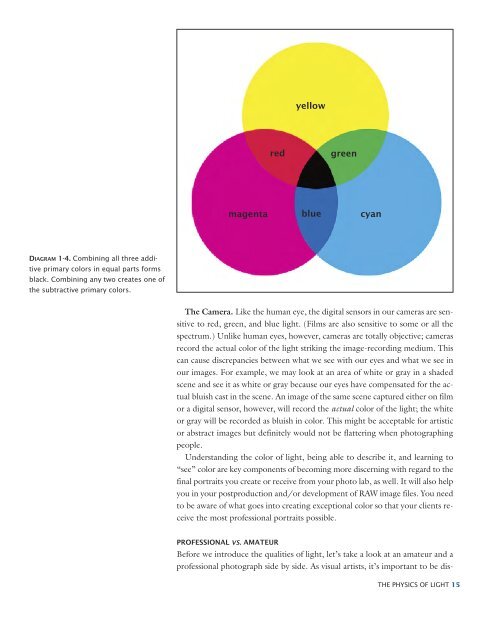Light Modifiers
Create successful ePaper yourself
Turn your PDF publications into a flip-book with our unique Google optimized e-Paper software.
DIAGRAM 1-4. Combining all three addi-<br />
tive primary colors in equal parts forms<br />
black. Combining any two creates one of<br />
the subtractive primary colors.<br />
yellow<br />
red green<br />
magenta blue<br />
cyan<br />
The Camera. Like the human eye, the digital sensors in our cameras are sensitive<br />
to red, green, and blue light. (Films are also sensitive to some or all the<br />
spectrum.) Unlike human eyes, however, cameras are totally objective; cameras<br />
record the actual color of the light striking the image-recording medium. This<br />
can cause discrepancies between what we see with our eyes and what we see in<br />
our images. For example, we may look at an area of white or gray in a shaded<br />
scene and see it as white or gray because our eyes have compensated for the actual<br />
bluish cast in the scene. An image of the same scene captured either on film<br />
or a digital sensor, however, will record the actual color of the light; the white<br />
or gray will be recorded as bluish in color. This might be acceptable for artistic<br />
or abstract images but definitely would not be flattering when photographing<br />
people.<br />
Understanding the color of light, being able to describe it, and learning to<br />
“see” color are key components of becoming more discerning with regard to the<br />
final portraits you create or receive from your photo lab, as well. It will also help<br />
you in your postproduction and/or development of RAW image files. You need<br />
to be aware of what goes into creating exceptional color so that your clients receive<br />
the most professional portraits possible.<br />
PROFESSIONAL VS. AMATEUR<br />
Before we introduce the qualities of light, let’s take a look at an amateur and a<br />
professional photograph side by side. As visual artists, it’s important to be dis-<br />
THE PHYSICS OF LIGHT 15



